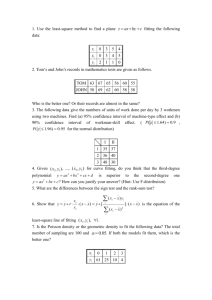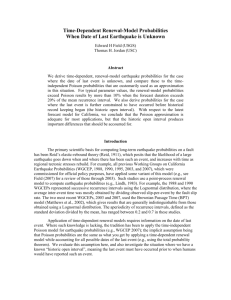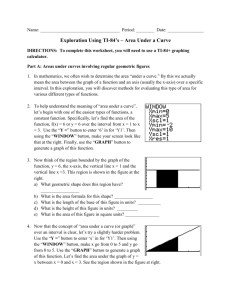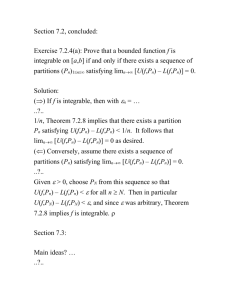Derivation of the Poisson distribution
advertisement
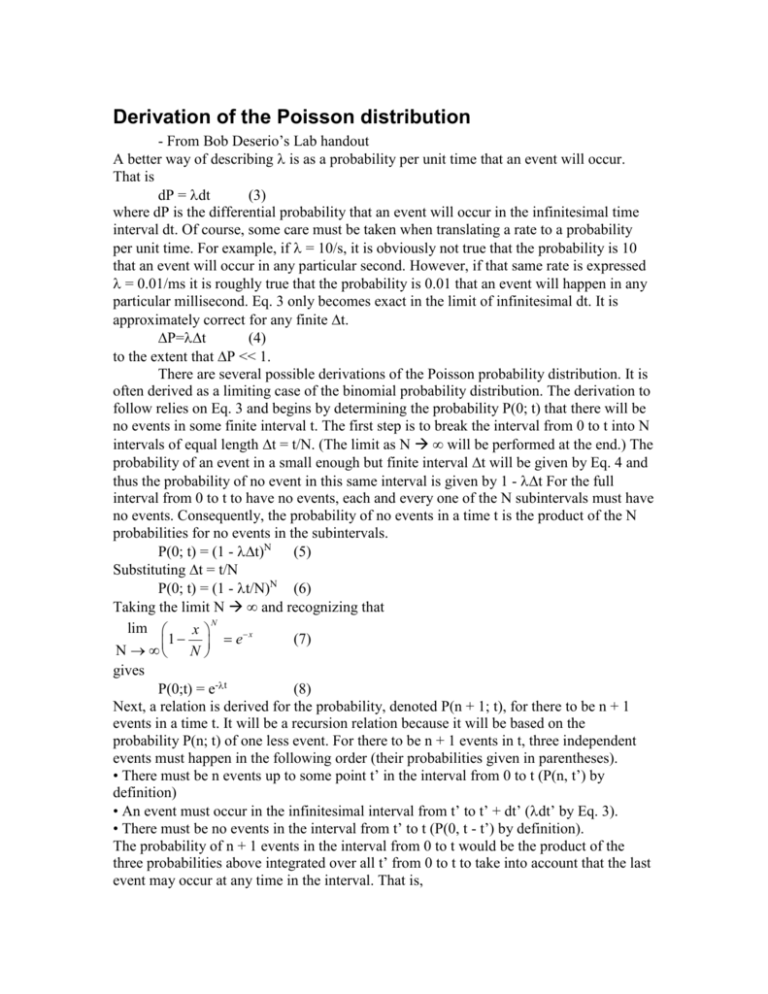
Derivation of the Poisson distribution - From Bob Deserio’s Lab handout A better way of describing is as a probability per unit time that an event will occur. That is dP = dt (3) where dP is the differential probability that an event will occur in the infinitesimal time interval dt. Of course, some care must be taken when translating a rate to a probability per unit time. For example, if = 10/s, it is obviously not true that the probability is 10 that an event will occur in any particular second. However, if that same rate is expressed = 0.01/ms it is roughly true that the probability is 0.01 that an event will happen in any particular millisecond. Eq. 3 only becomes exact in the limit of infinitesimal dt. It is approximately correct for any finite t. P=t (4) to the extent that P << 1. There are several possible derivations of the Poisson probability distribution. It is often derived as a limiting case of the binomial probability distribution. The derivation to follow relies on Eq. 3 and begins by determining the probability P(0; t) that there will be no events in some finite interval t. The first step is to break the interval from 0 to t into N intervals of equal length t = t/N. (The limit as N will be performed at the end.) The probability of an event in a small enough but finite interval t will be given by Eq. 4 and thus the probability of no event in this same interval is given by 1 - t For the full interval from 0 to t to have no events, each and every one of the N subintervals must have no events. Consequently, the probability of no events in a time t is the product of the N probabilities for no events in the subintervals. P(0; t) = (1 - t)N (5) Substituting t = t/N P(0; t) = (1 - t/N)N (6) Taking the limit N and recognizing that N lim x 1 e x (7) N N gives P(0;t) = e-t (8) Next, a relation is derived for the probability, denoted P(n + 1; t), for there to be n + 1 events in a time t. It will be a recursion relation because it will be based on the probability P(n; t) of one less event. For there to be n + 1 events in t, three independent events must happen in the following order (their probabilities given in parentheses). • There must be n events up to some point t’ in the interval from 0 to t (P(n, t’) by definition) • An event must occur in the infinitesimal interval from t’ to t’ + dt’ (dt’ by Eq. 3). • There must be no events in the interval from t’ to t (P(0, t - t’) by definition). The probability of n + 1 events in the interval from 0 to t would be the product of the three probabilities above integrated over all t’ from 0 to t to take into account that the last event may occur at any time in the interval. That is, t P n 1; t P n; t ' dt ' P 0; t t ' (9) 0 From Eq. 8 we already have P(0; t -t’) = e-t(t-t’) and with the following definition P n; t et P n; t (10) substituted, Eq. 9 becomes (after canceling e-t from both sides): t P n 1; t P n; t ' dt ' (11) 0 From Eqs. 8 and 10, P 0; t 1 and then P 1; t can be found from an application of Eq. 11 t P 1, t P 0, t dt t (12) 0 Applying Eq. 11 for the next few terms … the pattern clearly emerges that P n; t t n (15) n! Thus with Eq. 10, the Poisson probabilities result P n; t e t t n (16) n! BobC - truncating and shortening BobD Using = t as the “expected” number of events P n e n (17) n! BobD also derives that <n> = nP n = (21) n And n2 n2 P n 2 (23) n 0 Leading to 2 n 2 n2 2 (22)








